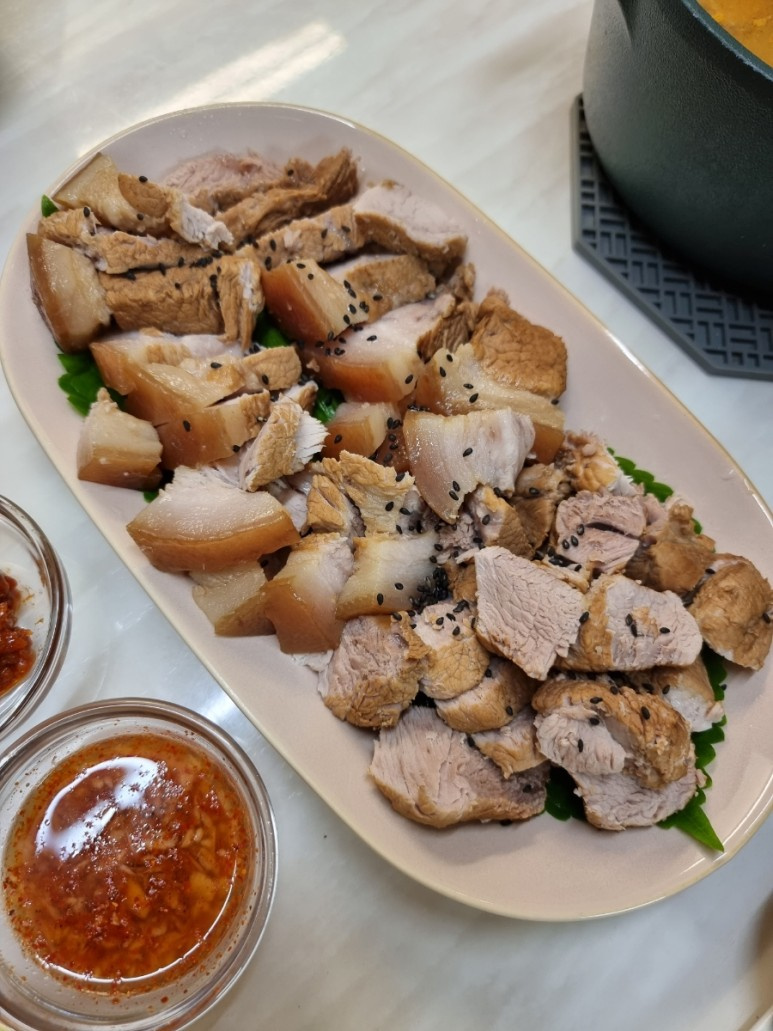Tender and Flavorful Pork Shoulder Boiled Meat (Suyuk)
The Ultimate Boiled Pork Shoulder (Suyuk) Recipe: Achieve Tender, Flavorful Results Without Gamey Odors

Boiled pork belly (Bossam) is one of those dishes that feels too expensive to buy out! It’s simply boiled meat, so why does it cost so much when dining out? I always make my own pork boiled meat at home. Today, I’m sharing my recipe for delicious pork shoulder boiled meat that you can enjoy at a great price. I’ll guide you through every step to make it easy for anyone to follow!
Ingredients- Pork shoulder 1kg (approx. 2.2 lbs)
- Water 1.5 liters (approx. 6.3 cups)
- Green onions 2-3 stalks
- Onion 1/2
- Garlic cloves 5-6
- Instant coffee 1 sachet (e.g., KANU)
- Doenjang (fermented soybean paste) 1 Tbsp
- Bay leaves (optional)
- Whole peppercorns (optional)
Cooking Instructions
Step 1
First, prepare about 1kg (approximately 2.2 lbs) of fresh pork shoulder. This amount is plenty for two people to enjoy a hearty meal. You can often find this at local markets for a very reasonable price, under 10,000 KRW!

Step 2
To remove any gamey odor, it’s crucial to soak the pork to drain excess blood. Fill a deep bowl with cold water and submerge the pork for about 30 minutes. Cutting the pork into three pieces, as shown in the photo, helps the blood to drain more effectively. If your bowl is large enough, you can soak it whole.

Step 3
While the pork is soaking, let’s prepare the aromatics for boiling. Take half an onion and wash it thoroughly, keeping the peel on. The onion peel not only helps to eliminate odors but also contributes to a richer color in the broth. Don’t forget to add plenty of green onions and garlic cloves as well.

Step 4
Carefully place the drained pork into a pot. For 1kg of pork shoulder, add about 1.5 liters (approximately 6.3 cups) of water, ensuring the pork is fully submerged. Having enough water is key for even cooking.

Step 5
Now, turn on the heat and bring the water to a boil. As soon as you turn on the heat, add 1 tablespoon of doenjang (fermented soybean paste) and 1 sachet of instant coffee. These are the secret ingredients that effectively tackle any unwanted porky smell!

Step 6
Doenjang and coffee not only eliminate odors but also give the meat a beautiful, appetizing golden-brown hue. If you have bay leaves or whole peppercorns on hand, feel free to add them too. While not essential, they will enhance the overall flavor profile.

Step 7
Boil the pork vigorously over high heat with the lid on for about 25 minutes. Keep an eye on the pot to ensure the water doesn’t boil over. Cooking at high heat initially helps to seal in the juices.

Step 8
After boiling on high heat for 20-25 minutes, check if the meat is cooked through by lifting the lid. Cooking times can vary depending on your stove’s heat. For instance, on my induction cooktop, the pork was almost done after about 20 minutes. I’ll explain how to check for doneness in the next step.

Step 9
The most reliable way to check if the pork is cooked is by piercing it with a chopstick or skewer. If clear juices run out, it’s ready. If you see pinkish liquid, it needs a bit more cooking time. For an even more tender texture, you can simmer it over medium-high heat for an additional 10 minutes. The total cooking time is approximately 30 minutes, but always adjust based on your stove’s heat. Rather than relying strictly on the clock, it’s best to check by piercing the meat periodically.

Step 10
Once the pork is perfectly cooked, slice it into your desired serving pieces. Some people recommend boiling for a very long time, but I prefer to cook it just until it’s done to prevent it from falling apart too much. Over-boiling for more than an hour can result in meat that’s too mushy and difficult to eat. Adjust the cooking time according to your preference for tenderness. Enjoy your delicious homemade boiled pork!




